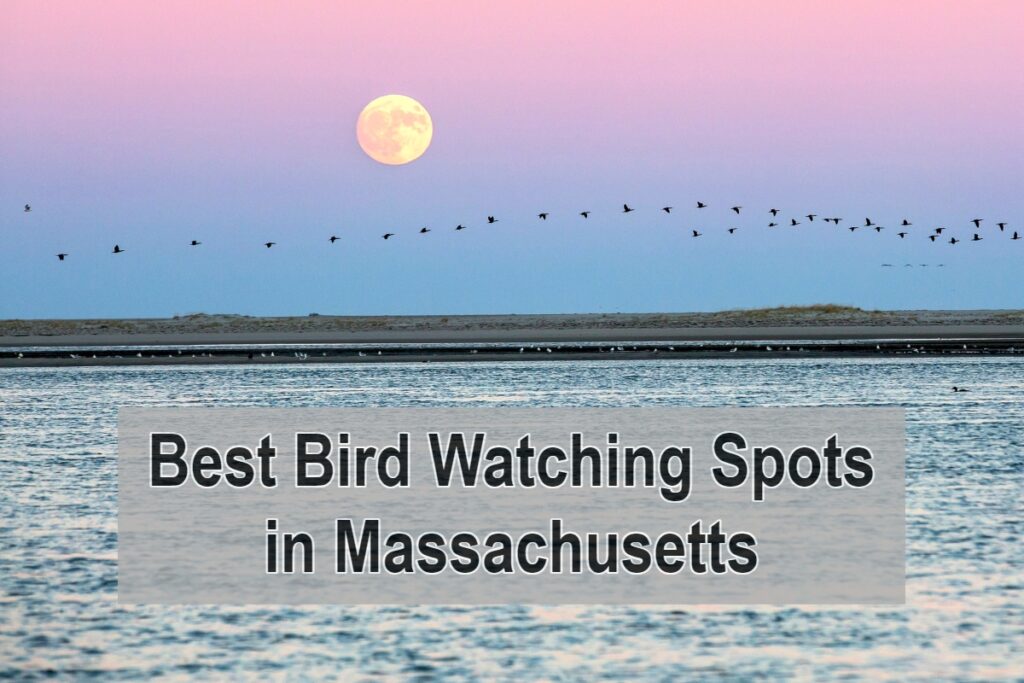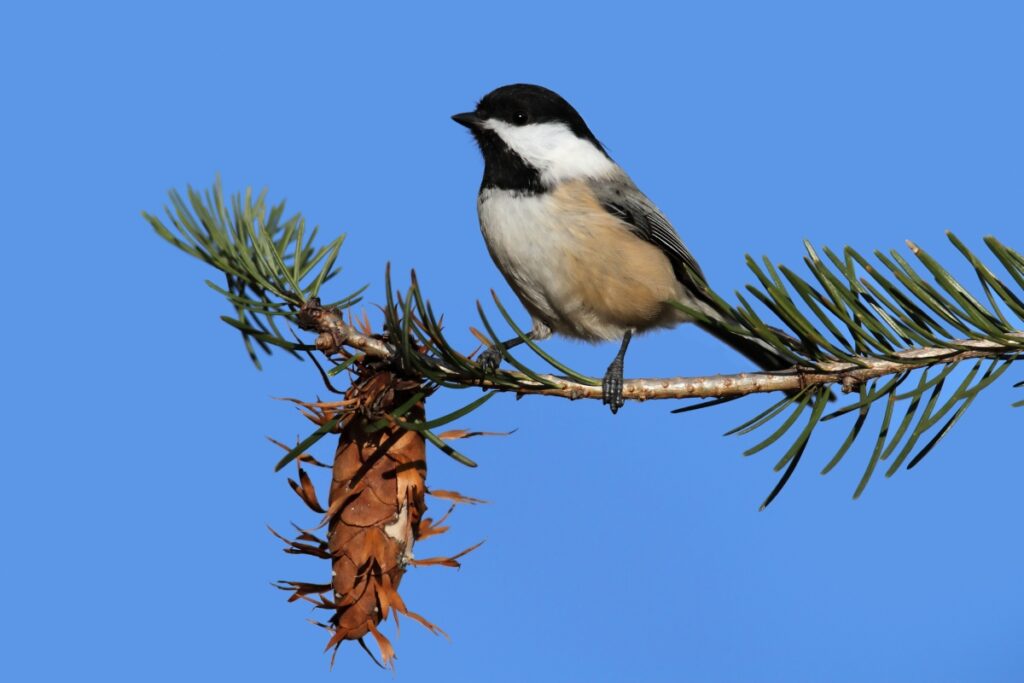As an Amazon Associate, we earn from qualifying purchases with no additional costs for you.
Massachusetts is a state in the New England area, which is on the eastern seaboard of the United States. Although the state has a high human population of 7 million, there are still many natural areas where you can see birds. I wrote this blog to help you learn which are the best bird watching sites to visit in Massachusetts.
The best bird watching spots in Massachusetts are those that have a range of habitats, such as at Daniel Webster Wildlife Sanctuary and those that are on the shores of the Atlantic Ocean, such as at Long Beach and Manomet Point. Parker River and Sandy Point on Plum Island are also good for birders.
A table giving the most interesting birds you can see at each of my top 14 birding spots in Massachusetts:
| PARK | INTERESTING BIRDS YOU CAN SEE |
|---|---|
| Parker River National Wildlife Refuge | Piping Plover and Saltmarsh Sparrow |
| Sandy Point State Reservation | White-winged Scoter and Common Eider |
| Belle Isle Marsh Reservation | Brant and American Oystercatcher |
| Manomet Point in Plymouth | Red-necked Grebe and Long-tailed Duck |
| Long Beach, Plymouth | Roseate Tern and Least Tern |
| Daniel Webster Wildlife Sanctuary | Bobolink, Osprey, and Northern Bobwhite |
| Joppa Flats in Newbury Port | King Eider and Western Sandpiper |
| Fort Hill at Cape Cod | Seaside Sparrow and Clapper Rail |
| Quabbin Reservoir | Ruffed Grouse and Bald Eagle |
| Wellfleet Bay Wildlife Sanctuary | Piping Plover and American Black Duck |
| Mount Auburn Cemetery | Cape May Warbler and Gray-cheeked Thrush |
| Great Meadows National Wildlife Refuge | Hooded Merganser and Virginia Rail |
| Cape Ann Peninsula | Ivory Gull and Razorbill |
| Halibut Point | Black-legged Kittiwake and Black-backed Gull |
Read on below to find out more information about my favorite and best bird watching spots in Massachusetts. You can also learn about which species you are most likely to find in each of my top birding spots.
TIP: If you want to check out the best pair of binoculars for bird watching, we recommend a pair of waterproof and fog-proof 8 x 42 binoculars like the Celestron – Outland X 8×42 Binoculars (Amazon link).
Best Places to Bird Watch in Massachusetts
There are many good birding sites in the state. Some are on the coast on Plum Island, while others are inland and have a range of habitats, including wetlands and woodlands.
1. Parker River National Wildlife Refuge
Parker River National Wildlife Refuge is located on the barrier island called Plum Island. This is a 4,700-acre refuge consisting mainly of salt marsh vegetation, but there are bogs, forestlands, shrubs, and freshwater marshes.
At least 360 species have been recorded here, making this a must-visit spot for bird watchers in the state. There is a 6.5-mile drive you can take through the refuge and trails you can take, like the Hellcat Interpretive Trail, which is popular among birders.
The refuge includes part of the Atlantic Ocean beach and is an important nesting site for the Piping Plover. Part of the beach is closed during Piping Plover nesting season to protect the birds.
This refuge is also a good spot for the Saltmarsh Sparrow and birds like Marsh Wrens and Soras. Both King Rails and Virginia Rails have also been sighted in the marshy areas.
Winter is when you can see Long-tailed Ducks and Red-throated Loons and possibly rarer oceanic bird species like Razorbills and Dovekies.
2. Sandy Point State Reservation
This is another birding hotspot on Plum Island, but Sandy Point is on the southernmost tip of the island and only 77 acres in size. A total of 263 bird species have been recorded in this part of the island.
You can see such bird species as:
- Canada Geese,
- Wood Ducks,
- King Eider,
- Lesser Scaup,
- Greater Scaup,
- White-winged Scoter,
- Common Eider,
- Surf Scoter,
- Common Goldeneye,
- Bufflehead,
- and Horned Grebe.
There are many more birds you can see from this point, so it is a good idea to include this site along with your trip to Parker River.
3. Belle Isle Marsh Reservation
This is a large salt marsh that is located north of Boston Logan Airport. There are also grasslands and trees scattered around the area.
If you visit, you can use the boardwalks and trails to access the different parts of the refuge. There are observation decks along the way where you can stop and spend some time scanning the vegetation and water for birds.
August is thought of as the best time to visit this area to see the greatest variety of birds. Bird species you can see here include:
- Brant,
- Saltmarsh Sparrow,
- Bufflehead,
- Green-winged Teal,
- and shorebirds.
Some of the shorebird species to watch for include:
- American Oystercatcher,
- Willet,
- Virginia Rail,
- and Least Bittern.
You may see Snowy Owls, Northern Harriers, and even Snow Buntings in the refuge during winter.
4. Manomet Point in Plymouth
Manomet Point is a good lookout spot for scanning the ocean for signs of birds like gannets, razorbills, and more.
Species you can see include Long-tailed Duck, Red-necked Grebe, Red-throated Loon, Razorbill, Dovekie, and Northern Gannet. You may also see Purple Sandpipers on the rocky shore here in winter.
5. Long Beach, Plymouth
This is a 2.5-mile area of sand that is important for nesting species like:
- Least Tern,
- Piping Plover,
- Roseate Tern,
- and Common Tern.
Many of these terns and plovers are of conservation concern. Winter is a good time to see some species like:
- Common Loon,
- Brant,
- Iceland Gull,
- and Great Cormorant.
6. Daniel Webster Wildlife Sanctuary
This is a 578-acre area that is found in Marshfield. The Massachusetts Audubon Society owns and manages the sanctuary. There is a range of habitats, including woodlands, grasslands, and wetlands, and more than 3 miles of trails you can walk on.
The Daniel Webster Wildlife Sanctuary is a good spot for birding. You can find birds such as:
- Ospreys,
- Wood Ducks,
- Eastern Bluebirds,
- Wild Turkeys,
- and Northern Bobwhites.
The Bobwhites and Turkeys are likely to be on the ground, so you should keep this in mind when bird watching in the sanctuary. Grasslands in the sanctuary often have species like:
- Eastern Meadowlark,
- Savannah Sparrow,
- and Bobolink.
7. Joppa Flats in Newbury Port
There is an education center here that offers several guided walks. This is a great opportunity for novice and expert birders alike.
Joppa Flats is good for many birds, including shorebirds. At least 227 species of birds have been recorded here. You can use the checklist for the site.
You can find species like:
- Black-crowned Night Herons,
- Glossy Ibis,
- Roseate Tern,
- Purple Sandpipers,
- Buff-breasted Sandpipers,
- Baird’s Sandpipers,
- and Western Sandpipers.
Various waterfowl have been spotted as well, including:
- King Eiders,
- Black Scoters,
- Ring-necked Ducks,
- and Canvasbacks.
TIP: Knowing how to spot the birds in your yard is key to enjoying visits from your winged friends as much as possible! The best sources are trusted books, I recommend using the following (Amazon links):
– National Geographic Field Guide to the Birds of North America
– National Audubon Society Birds of North America
8. Fort Hill at Cape Cod
Fort Hill has a trail that passes through grassland and connects with a trail offering a chance to scan the Nauset Marsh area for birds. Snowy Egrets, Black-crowned Night-Herons, and Great Egrets can be seen here. Osprey is also often present.
There are also Willow Flycatchers, Northern Bobwhites, and various marsh-loving birds you can find here. Some of the species to look for in the marsh include:
- American Bittern,
- Sora,
- Clapper Rail,
- Seaside Sparrow,
- and Marsh Wren.
Seaside Sparrows specialize in brackish water habitats, so they should be looked for in tidal marshes here.
9. Quabbin Reservoir
Quabbin Reservoir is situated in the central part of the state. This is a good spot to find waterfowl like Common Loons, Common Mergansers, Wood Ducks, and Hooded Mergansers. You can also find other birds, like Bald Eagles and Double-crested Cormorants.
Ruffed Grouse and Bald Eagles nest in the area, as do several other birds like:
- Common Ravens,
- Pileated Woodpeckers,
- Hermit Thrushes,
- and Veerys.
Warblers that breed in the trees by the reservoir include a range of species, including the following:
- Black-throated Green Warbler,
- Black-throated Blue Warbler,
- Blackburnian Warbler,
- and Blue-winged Warbler.
10. Wellfleet Bay Wildlife Sanctuary
This sanctuary is 937 acres in size and has a species list of close to 300 species. There are salt marshes, woodlands of pine trees, and a sandy beach area.
The end of summer into fall is the best time to visit the sanctuary for bird watchers. You can see a variety of species, such as:
- Snowy Egrets,
- Lesser Yellowlegs,
- Spotted Sandpipers,
- Solitary Sandpipers,
- Greater Yellowlegs,
- American Oystercatchers,
- Piping Plovers,
- and various raptor species, including Peregrine Falcons.
You should also look for Clapper Rails in the marshes and Tree Swallows flying overhead. Other bird species in the sanctuary include:
- Least Tern,
- American Black Duck,
- Red-breasted Nuthatch,
- Common Yellowthroat,
- Baltimore Oriole,
- Orchard Oriole,
- Prairie Warbler,
- Yellow Warbler,
- and Pine Warbler.
There is a printable checklist available for the site and more information on the bird conservation projects that have taken place at Wellfleet Bay.
TOP TIP: Understanding the best practices for birding according to season and what birds may be likely to eat in certain seasons are critical aspects of bird watching that can help improve your ability to find the birds you are after.
11. Mount Auburn Cemetery
This area is 175 acres and has many trees growing in the area, providing a good resting place for migrating bird species. May is the best time to visit Mount Auburn Cemetery for bird watching, and there are also sometimes guided walks for birders.
You can find species like:
- Cape May Warbler,
- Gray-cheeked Thrush,
- Hooded Warbler,
- Cerulean Warbler,
- Summer Tanager,
- Mourning Warbler,
- Worm-eating Warbler,
- and many more birds.
12. Great Meadows National Wildlife Refuge
This is a 3,800-acre area made up of a lot of wetlands but also has mixed pine woodlands. There are trails you can go on when looking for birds.
About 260 bird species have been recorded in the refuge. Besides the trails, there is also an observation tower that you can use when scanning the area for birds.
The refuge is good for a variety of birds, including the following:
- Virginia Rail,
- Least Bittern,
- American Bittern,
- Pine Warbler,
- Blue-winged Warbler,
- and Ovenbird.
Mudflats in summer work well for attracting shorebirds to the refuge.
13. Cape Ann Peninsula
The Cape Ann Peninsula in the Gloucester area is a good place to spot birds in the sea. The oceanic birds are often most likely to be spotted in winter.
Species to look for include King Eider, Harlequin Duck, Northern Gannet, and Ivory Gull. For the Ivory Gull, you should look along the rocky areas of the peninsula.
The Atlantic Puffin is rare to see in the area, but it has been spotted before so you should keep your eyes open.
Other birds to look for off the peninsula include:
- Common Murres,
- Thick-billed Murres,
- Razorbills,
- Dovekies,
- Long-tailed Ducks,
- and Red-throated Loons.
You may also see Horned Grebes and Red-necked Grebes.
TIP: Check out my recommended products if you are looking for the best and trusted equipment for birdwatching in the wild or on your backyard (Amazon link):
- Celestron Outland X 8×42 Binoculars
- Celestron Ultima 80 Angled Spotting Scope
- National Audubon Society Birds of North America Book
- Design Free-standing Bird Bath
- Smart Bird Feeder with Camera
- Cedar Bird House for Outside
14. Halibut Point
This is a region on the Cape Ann Peninsula, which is at Rockport. This spot is a good place to see birds, with more than 276 species recorded in this area at Halibut Point.
Birds to look out for here include:
- Herring Gulls,
- Black-backed Gulls,
- Surf Scoters,
- Black Scoters,
- White-winged Scoters,
- Harlequin Ducks,
- Common Murres,
- Black Guillemots,
- Black-legged Kittiwakes,
- and Dovekies.
Many of these species are found in winter, so this would be the best time to visit this spot while in the Cape Ann area.
Best Time to Bird Watch in Massachusetts
A person can bird watch any time of the year in Massachusetts because you will always see birds. However, certain seasons are better for spotting particular kinds of bird species.
| TYPES OF BIRDS | SEASON |
|---|---|
| Snowy Owl and Snow Bunting | Winter |
| Black-crowned Night Heron and Osprey | Summer |
The Massachusetts State Bird
The Massachusetts State Bird is the Black-capped Chickadee. This is a little bird that is quite bold and can be seen in well-wooded gardens and parks, as well as in deciduous woodlands. Chickadees forage by hopping among branches and searching for insects.
These birds will also eat fruits and berries and will even visit feeders for seed, especially when conditions worsen and other food is scarce.
Bird Watching Laws in Massachusetts
You are not allowed to have, catch, or harm any wild bird, including their nests and eggs. This law does not apply to exotic invasives like the Rock Pigeon, House Sparrow, and European Starling.
My Favourite Equipment for Bird Watching
Bird watching is one of the least expensive hobbies out there, but you still need some equipment to get the most out of it.
The essential equipment to start bird watching is a pair of binoculars. My preference is 8 X 42 binoculars. The number 8 is how much the magnification is, while 42 is the field of view in millimeters of the lenses.
A pair of waterproof and fog-proof 8 x 42 binoculars like the Celestron – Outland X 8×42 Binoculars on Amazon is an excellent choice for both beginners and experts.
In time, you can choose more expensive models and also opt to buy a spotting scope like the Celestron Ultima 80 on Amazon.
These are a lot more expensive compared with binoculars though, so if you are only a beginner, start with binoculars first. A spotting scope is only helpful for birds far away, such as out on a pond or seashore.
There are a few rules or guidelines you should abide by as an ethical birder. These are listed below.
- Do not enter private lands without prior permission from landowners.
- Follow all the rules in refuges and reserves, including cleaning up any garbage from your campsite.
- Do not disturb birds on nests.
- Do not use apps and play songs to call up birds when they are hungry, tired, and breeding during spring and summer.
Conclusion
Massachusetts has a lot to offer the novice and expert bird watcher because you have the Atlantic Ocean shoreline, islands, inland woodlands, grasslands, and wetlands.
There are always good opportunities for bird watching in the state. I would recommend adding Massachusetts to your list of birding sites in North America.
TIP: If you want to check out the best pair of binoculars for bird watching, we recommend a pair of waterproof and fog-proof 8 x 42 binoculars like the Celestron – Outland X 8×42 Binoculars (Amazon link).


